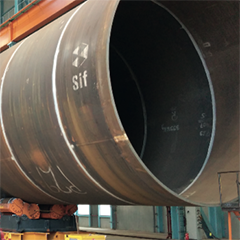24SEA has been involved in various projects over the last years all focussing on foundation monitoring. Typically, up to 10% of the foundations within offshore wind farms are equipped with a Foundation Structural Health Monitoring (FSHM) system, consisting mainly of installing accelerometers and strain gauges in the transition piece. In the recent projects, for both the Belgian wind farm Nobelwind and the UK wind farm Galloper, 24SEA teamed up with TUBS and Com&Sens, to equip monopiles with optical strain gauges over the entire length of the monopile. With this innovative set-up, the projects aim to better understand the subsoil dynamics and to validate new design methodologies for the soil structure interaction.
In addition, the subsoil sensors can be used to access the lifetime directly near the critical welds and validate the concept of virtual sensing below the mudline, where strains over the entire substructure are predicted using accelerometers only. In this piece, we will discuss the first results obtained from the optical strain gauges installed on the monopile.
Motivation
Offshore wind turbines (OWTs) are some of the most dynamic civil structures. The substructures of OWTs are loaded by both wind and waves, and agitated by the rotations of the wind turbine on top. The most common substructure design in offshore wind is the so-called monopile foundation, which represents over 80% of all offshore wind turbines. A monopile foundation is a single cylindrical pile with diametres ranging from 4 to 8 metres and lengths up to 70 metres.
The design of an offshore wind turbine on monopile foundation is strongly driven by the dynamic interaction between the periodic wave-loading, the rotor harmonic loads (e.g. unbalances or blades passing) and the first structural resonance frequency. The entire structure is designed ‘soft-stiff’ in which the 1st resonance frequency is positioned between the 1P (unbalance) and 3P (blade passing) rotor harmonics. With the growing size of wind turbines this frequency has dropped significantly in the past years. As a result the OWT first resonance frequency is closer to the wave period, increasing the resonant behavior and the subsequent fatigue loading.



























